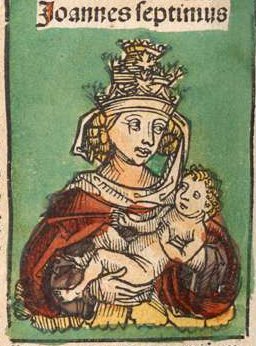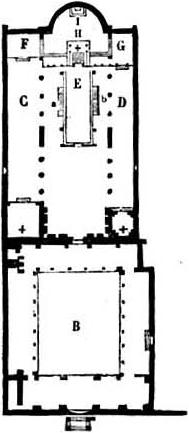|
Pope Joan
Pope Joan (''Ioannes Anglicus'', 855–857) was, according to legend, a woman who reigned as pope for two years during the Middle Ages. Her story first appeared in chronicles in the 13th century and subsequently spread throughout Europe. The story was widely believed for centuries, but most modern scholars regard it as fictional. Most versions of her story describe her as a talented and learned woman who disguised herself as a man, often at the behest of a lover. In the most common accounts, owing to her abilities she rose through the church hierarchy and was eventually elected pope. Her sex was revealed when she gave birth during a procession and she died shortly after, either through murder or of natural causes. The accounts state that later church processions avoided this spot and that the Vatican removed the female pope from its official lists and crafted a ritual to ensure that future popes were male. In the 16th century, Siena Cathedral featured a bust of Joan among other ... [...More Info...] [...Related Items...] OR: [Wikipedia] [Google] [Baidu] |
Stephen Of Bourbon
Stephen of Bourbon (French: ''Étienne de Bourbon''; Latin: ''Stephanus de Borbone''; 1180 – 1261) was a preacher of the Dominican Order, author of the largest collection of preaching ''exempla'' of the thirteenth century, a historian of medieval heresies, and one of the first inquisitors. Stephen was born in Belleville in the archdiocese of Lyon towards the end of the twelfth century. Having received his education from the cathedral clergy in Macon, he undertook his higher studies in Paris, about 1220, and shortly afterwards entered the Order of Preachers. From 1230 he was very active for many years as a preacher and inquisitor in the districts of Lyonnais, Burgundy, Franche-Comté, Savoy, Champagne, Lorraine, Auvergne, Languedoc, and Roussillon. His work for preachers, ''Tractatus de diversis materiis praedicabilibus'' ("A Treatise on Various Preachable Materials"), includes material drawn from his many years of practical experience, as well as a number of stories from the ... [...More Info...] [...Related Items...] OR: [Wikipedia] [Google] [Baidu] |
Testicle
A testicle or testis (plural testes) is the male reproductive gland or gonad in all bilaterians, including humans. It is homologous to the female ovary. The functions of the testes are to produce both sperm and androgens, primarily testosterone. Testosterone release is controlled by the anterior pituitary luteinizing hormone, whereas sperm production is controlled both by the anterior pituitary follicle-stimulating hormone and gonadal testosterone. Structure Appearance Males have two testicles of similar size contained within the scrotum, which is an extension of the abdominal wall. Scrotal asymmetry, in which one testicle extends farther down into the scrotum than the other, is common. This is because of the differences in the vasculature's anatomy. For 85% of men, the right testis hangs lower than the left one. Measurement and volume The volume of the testicle can be estimated by palpating it and comparing it to ellipsoids of known sizes. Another method is to use caliper ... [...More Info...] [...Related Items...] OR: [Wikipedia] [Google] [Baidu] |
Marianus Scotus
Marianus Scotus (1028–1082 or 1083) was an Irish monk and chronicler. He authored the ''Chronica Clara'', a history of the world. Name Marianus Scotus is Latin for "Marian the Scot", although that term at the time was still inclusive of the Irish. He is sometimes known as to distinguish him from Marianus Scotus of Regensburg and sometimes called (Modern ir, Maelbhríde), "Brigit's Servant". The name "Marianus" }), which purports to be a universal history from the creation of the world to 1082 and which employed a dual numbering scheme on the misunderstanding that the Christian era computed by Dionysius Exiguus had been mistaken by 22 years. The chronicle was very popular during the Middle Ages and, in England, was extensively used by John of Worcester and other writers. It was first printed at Basel in 1559 and has been edited with an introduction by Georg Waitz for the ''Monumenta Germaniae HistoricaScriptores'', Vol. VSee also W. Wattenbach, ''Deutschlands Geschichtsque ... [...More Info...] [...Related Items...] OR: [Wikipedia] [Google] [Baidu] |
Vatican Library
The Vatican Apostolic Library ( la, Bibliotheca Apostolica Vaticana, it, Biblioteca Apostolica Vaticana), more commonly known as the Vatican Library or informally as the Vat, is the library of the Holy See, located in Vatican City. Formally established in 1475, although it is much older—it is one of the oldest libraries in the world and contains one of the most significant collections of historical texts. It has 75,000 codices from throughout history, as well as 1.1 million printed books, which include some 8,500 incunabula. The Vatican Library is a research library for history, law, philosophy, science, and theology. The Vatican Library is open to anyone who can document their qualifications and research needs. Photocopies for private study of pages from books published between 1801 and 1990 can be requested in person or by mail. Pope Nicholas V (1447–1455) envisioned a new Rome with extensive public works to lure pilgrims and scholars to the city to begin its transf ... [...More Info...] [...Related Items...] OR: [Wikipedia] [Google] [Baidu] |
Liber Pontificalis
The ''Liber Pontificalis'' (Latin for 'pontifical book' or ''Book of the Popes'') is a book of biographies of popes from Saint Peter until the 15th century. The original publication of the ''Liber Pontificalis'' stopped with Pope Adrian II (867–872) or Pope Stephen V (885–891), but it was later supplemented in a different style until Pope Eugene IV (1431–1447) and then Pope Pius II (1458–1464). Although quoted virtually uncritically from the 8th to 18th centuries, the ''Liber Pontificalis'' has undergone intense modern scholarly scrutiny. The work of the French priest Louis Duchesne (who compiled the major scholarly edition), and of others has highlighted some of the underlying redactional motivations of different sections, though such interests are so disparate and varied as to render improbable one popularizer's claim that it is an "unofficial instrument of pontifical propaganda." The title ''Liber Pontificalis'' goes back to the 12th century, although it only became c ... [...More Info...] [...Related Items...] OR: [Wikipedia] [Google] [Baidu] |
Anastasius Bibliothecarius
Anastasius Bibliothecarius or Anastasius the Librarian (c. 810 – c. 878) was ''bibliothecarius'' (literally "librarian") and chief archivist of the Church of Rome and also briefly a claimant to the papacy. Early life He was a nephew of Bishop Arsenius of Orte, who executed important commissions as Papal legate. Anastasius learned the Greek language from Eastern Roman monks and obtained an unusual education for his era, such that he appears to be the most learned ecclesiastic of Rome in the 9th century.Kirsch, Johann Peter. "Anastasius Bibliothecarius." The Catholic Encyclopedia Vol. 16 (Index). New York: The Encyclopedia Press, 1914. 13 December 2018 Abbot of Santa Maria and secretary of Nicholas I During the pontificate of[...More Info...] [...Related Items...] OR: [Wikipedia] [Google] [Baidu] |
Bishop Of Ostia
The Roman Catholic Suburbicarian Diocese of Ostia is an ecclesiastical territory located within the Metropolitan City of Rome in Italy. It is one of the seven suburbicarian dioceses. The incumbent Bishop is cardinal Giovanni Battista Re. Since 1150, its bishop has been the Dean of the College of Cardinals, Its Cathedral is Basilica di Sant'Aurea. From 1105 to 1914, the diocese was merged with the Suburbicarian Diocese of Velletri. In 1962, the Diocese of Ostia was brought under the direct administration of the Diocese of Rome. Bishops Bishops of Ostia (-1057) * aximus (259):... *Maximus (313) *Florentius (366) :''...'' *Bonus (487). *Bellator (499) *Aristus (502) :... *Amabile (649) :... *Andrea(s) (680) :... *Sissinio 732 – before 745 *Theodorus (745) * George I, 753–786 :''...'' * Gregory I, 787 – before 804 * Bernard 804–805 * Peter I 805 – before 826 * Cesareo 826–854 * Megisto (or Leo I), 854–868 * Donatus, 868–870 :''sede vacante 870–878'' * Eugenius, 8 ... [...More Info...] [...Related Items...] OR: [Wikipedia] [Google] [Baidu] |
Basilica Of San Clemente
The Basilica of Saint Clement ( it, Basilica di San Clemente al Laterano) is a Latin Catholic minor basilica dedicated to Pope Clement I located in Rome, Italy. Archaeologically speaking, the structure is a three-tiered complex of buildings: (1) the present basilica built just before the year 1100 during the height of the Middle Ages; (2) beneath the present basilica is a 4th-century basilica that had been converted out of the home of a Roman nobleman, part of which had in the 1st century briefly served as an early church, and the basement of which had in the 2nd century briefly served as a mithraeum; (3) the home of the Roman nobleman had been built on the foundations of republican era villa and warehouse that had been destroyed in the Great Fire of AD 64. History This ancient church was transformed over the centuries from a private home that was the site of clandestine Christian worship in the 1st century to a grand public basilica by the 6th century, reflecting the emerging ... [...More Info...] [...Related Items...] OR: [Wikipedia] [Google] [Baidu] |
Colosseum
The Colosseum ( ; it, Colosseo ) is an oval amphitheatre in the centre of the city of Rome, Italy, just east of the Roman Forum. It is the largest ancient amphitheatre ever built, and is still the largest standing amphitheatre in the world today, despite its age. Construction began under the emperor Vespasian () in 72 and was completed in 80 AD under his successor and heir, Titus (). Further modifications were made during the reign of Domitian (). The three emperors that were patrons of the work are known as the Flavian dynasty, and the amphitheatre was named the Flavian Amphitheatre ( la, Amphitheatrum Flavium; it, Anfiteatro Flavio ) by later classicists and archaeologists for its association with their family name (Flavia (gens), Flavius). The Colosseum is built of travertine#Uses, travertine limestone, tuff (volcanic rock), and brick-faced Roman concrete, concrete. It could hold an estimated 50,000 to 80,000 spectators at various points in its history, having an average a ... [...More Info...] [...Related Items...] OR: [Wikipedia] [Google] [Baidu] |
Lateran
250px, Basilica and Palace - side view Lateran and Laterano are the shared names of several buildings in Rome. The properties were once owned by the Lateranus family of the Roman Empire. The Laterani lost their properties to Emperor Constantine who gave them to the Catholic Church in 311. The most famous Lateran buildings are the Lateran Palace, once called the Palace of the Popes, and the Archbasilica of Saint John Lateran, the cathedral of Rome, which although part of Italy is a property of the Holy See, which has extraterritorial privileges as a result of the 1929 Lateran Treaty. As the official ecclesiastical seat of the pope, Saint John Lateran is the papal ''cathedra''. The Lateran is Christendom's earliest basilica. Attached to the basilica is the Lateran Baptistery, one of the oldest in Christendom. Other constituent parts of the Lateran complex are the building of the Scala Sancta with the Sancta Sanctorum and the Triclinium of Pope Leo III. The Pontifical Lateran Uni ... [...More Info...] [...Related Items...] OR: [Wikipedia] [Google] [Baidu] |



